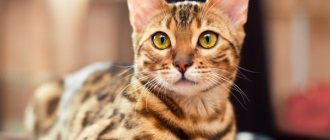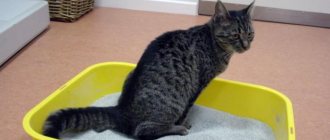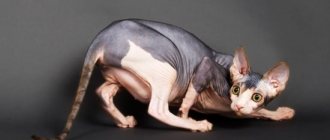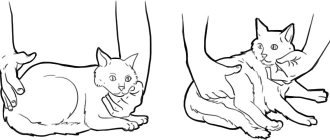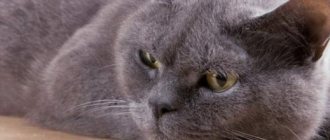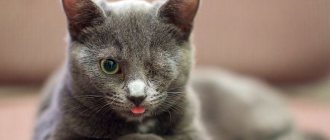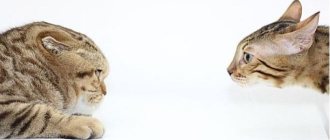Pathologies in which a cat falls on its side when walking
This symptom may include epilepsy, stroke, development of paralysis or paresis, muscle dystrophy or ataxia.
A cat with epilepsy falls on its side.
Depending on the nature of the pathology, the onset of symptoms can occur either slowly or rapidly.
.
In both cases, contacting a veterinarian is mandatory
. In addition to obvious signs, there may be a shaky, uncertain gait, fear of movement, and the animal cannot lean on one of its sides or limbs.
Paralysis or paresis
The development of paralysis or paresis can occur, inflammatory processes, and disturbances in the blood flow of the body.
But it can also be explained by injuries to the back and spine. With this disease, parallel symptoms are observed: fainting, “shifty” eyes - nystagmus, inappropriate behavior, pupils of different sizes.
With paralysis, fainting occurs.
If the lumbar or pelvic area is affected
, there may be a violation of the act of defecation and urination. Similar symptoms will occur with spinal cord oncology or with nutritional hyperparathyroidism.
Muscle weakness
Muscle weakness in a cat is accompanied by lethargy.
Muscle weakness is provoked by myopathy based on potassium deficiency in the body, infectious diseases, viruses, in particular botulism.
Parallel symptoms of internal bleeding may include cold extremities
, lethargy, refusal of food and water, constant drowsiness, bluish mucous membranes.
Ataxia
The presence of ataxia is characterized by periodic rolling over on one side.
Ataxia can be congenital or acquired depending on its occurrence factors.
They differ in appearance into vestibular, cortical, cerebellar, and sensitive forms.
. The presence of ataxia is characterized by an unsteady gait and periodic lying on one side.
- The animal walks very unsteadily, stepping on its paws with caution.
- The head is tilted down or to the side, muscle tremors are possible.
- The following are often involved in the development of pathology: various poisonings, traumatic brain injuries, cerebral edema.
- At the same time, cerebellar ataxia is most common in small kittens and occurs due to hypoplasia of the cerebellar structure.
Epileptic seizure
An epileptic seizure is manifested not only by falling on one side, but also by the onset of convulsions, twitching of the paws, involuntary closing of the jaws or uncontrolled urination.
During an epileptic seizure, convulsions occur in the cat.
Stroke
The stroke is accompanied by a loud cry in the cat.
During a stroke, the animal experiences circular movements and loud meowing due to severe pain. And also fainting.
Otitis
With otitis media, a cat has ear pain.
A possible reason for the appearance of this symptom may be otitis media, leading to a disorder in the functioning of the vestibular apparatus. Additional symptoms are loss of appetite, foul odor from the ear, discharge of purulent exudate, pain in the ear area.
Video about a cat with ataxia
How old is your pet? Ten? More? Then this is definitely the place for you! Because after 8-10 years, various age-related changes begin to occur in the cat’s body, which you need to be aware of and take into account. May your four-legged pet live happily ever after!
By the way, previously the age limit for our pets was much lower - 12-year-old cats were considered long-livers. It was man who raised the quality of life, and with it its duration, by one and a half to two times.
And now it is easy to meet cats that have reached 16-19 years of age, or even more. For example, in our clinic we see two cats, each 21 years old, and the most significant thing that worries them is their teeth, or rather, tartar, which is removed from them from time to time.
Well, the age of cats from the Guinness Book of Records generally exceeds the 30-year mark.
So, among pets, the number of “elderly” pets (approximately 30%) who need optimal care is increasing.
It is a fact that with the increase in the number of years lived, everything changes (and not only for cats :-)). Age-related changes affect all body functions. For now, we will consider only behavioral ones.
The causes of behavioral changes can be a number of diseases (including systemic ones) acquired by the animal over the years of its life, brain pathologies, as well as CDS - cognitive dysfunction syndrome. First, let's look at medical ailments, and then move on to the most interesting part.
Osteoarthritis
(joint disease) can be observed in 65% of cats over 12 years of age (the elbow and hip joints are most often affected, less often the knee and shoulder). Joint pain leads to decreased mobility and the appearance of aggressiveness when communicating with people and other animals.
Systemic hypertension
(high blood pressure) often causes the pet to scream at night, become disoriented in space, lose consciousness, senseless circular movements and even seizures.
Chronic kidney disease
most strongly influences behavior change: polyuria (increased volume of urine) entails urination in the wrong places, and with a lack of water, dehydration of brain tissue. Polydipsia (increased thirst) causes cats to drink from containers that are not intended for this purpose. The development of acidosis (increased body acidity) causes weight loss and drowsiness. And severe uremia (self-poisoning of the body with nitrogenous waste from urine) leads to uremic encephalopathy, a non-inflammatory disease of the brain. In addition, kidney disease is often accompanied by hypertension (see above).
Hyperthyroidism
(increased thyroid hormones) leads to the same consequences as chronic renal failure. In addition, it affects the concentration of thyroxine in the brain (manifests as anxiety and aggressiveness), causes polyphagia - the cat’s taste and appetite change.
Diabetes
has the same consequences as chronic renal failure and hyperthyroidism. In addition, it can cause sensory or motor neuropathies (irritability, increased sensitivity to external influences (touch), muscle pain).
Urinary tract infections
cause the animal pain and discomfort in the bladder or kidneys. The result is “incorrect” urination, anxiety, aggression, and depression.
Changes in appetite, weight loss, gastrointestinal diseases
, appearing due to physiological changes and pathological processes, are associated with a deterioration in the sense of smell and taste, pain in the oral cavity, for example, due to periodontal disease.
Hearing and vision loss
Cats quickly adapt to blindness. With deafness the situation is worse. Cats with poor hearing begin to make loud noises (possibly at night) because they have difficulty hearing their voices.
Brain tumors
more common in older cats (11 years and above). Meningioma, lymphoma, glioma, pituitary tumors are expressed by restlessness, circular movements and convulsions.
Pain
, especially constant, greatly exhausts the animal. Chronic pain most often occurs with artiritis, as well as with inflammatory processes in other organs, for example, with periodontal disease and diseases of the digestive tract (obstruction). Cats, due to their evolutionary development, are able to cope even with severe pain.
Infectious diseases
(viral immunodeficiency, viral leukemia, infectious peritonitis, toxoplasmosis) are the cause of neurological disorders and, consequently, behavioral changes.
So, there are many medical reasons for behavioral problems in older cats. And identifying them often requires a number of diagnostic studies. But if diseases are excluded, that is, when there is no obvious cause, then the animal’s behavior is considered to change under the influence of cognitive dysfunction syndrome
(SKD)
Alzheimer's? In cats?!
Yeah, something like that. Everything is like the big ones.
In cats with cognitive dysfunction syndrome, changes occur in the brain that lead to decreased mental abilities. This affects the processes of thinking, memory, learning new things, and using acquired skills.
Cognitive dysfunction syndrome
is a progressive disease with increasing signs of senile behavior
A third of 11-14 year old cats have at least one of the behavioral disorders caused by CDS, and in 15 year old cats the number of such problems is no less than 50%.
The most striking symptom of cognitive dysfunction is disorientation. The cat seems to get lost in the apartment, hides in a corner or under furniture, bumps into door frames in an attempt to find the door, does not recognize the owners or other animals, and does not respond to calls.
The sleep-wake pattern is often disrupted (as a rule, the cat sleeps more during the day and much less at night).
The proportion of purposeful actions decreases and the frequency of aimless wandering increases. There may be movements in a circle or involuntary oscillatory movements - tremor, or, conversely, immobility, weakness.
An older cat may go potty less often and go to inappropriate places more often.
The quality of communication with the owners deteriorates, the animal asks for less and less affection and attention.
The main reasons why a cat walks in circles
Cat breeders often encounter strange behavior from their pet. Along with the fact that the cat walks in a circle, you can notice how the animal crashes into walls, as if it does not see an obstacle, and also refuses to eat and loses orientation in space. All these signs refer to a serious condition. If you find something like this, you should sound the alarm and look for the cause of the strange behavior. Among the many negative factors are the following aspects:
- Helminthic infestations. One of the most common animal health problems. As a result of infestation with worms, cats begin to walk in circles and also rub their anus on the floor covering and interior items. You can often see your pet biting something out of the anus and trying to scratch the affected area with its teeth. Invasive infection causes an increase in appetite. Very often, owners note that the pet does not sleep well at night, meows often, and behaves restlessly and irritably. This disease forces the cat to walk around the room along the same route. Therefore, the owner should understand that if a cat walks in circles clockwise, but there is no clearly expressed disturbed orientation in space, then this is a helminthic infection. Treatment will require antihistamine therapy. As a rule, drugs such as Pyrantel are used. The dosage and duration of treatment is determined by the veterinarian after receiving tests. In most cases, one drug is enough for a complete cure;
- High blood pressure. Hypertension causes poor health not only in people, but also in animals. High blood pressure in cats in most cases occurs when the animal is already aged. Therefore, owners often notice how an old cat walks in a circle. Increased pressure in blood vessels can be not only an independent disease, but also a consequence of another serious illness, such as renal failure. Very often, veterinarians diagnose cats with kidney failure in an advanced form - chronic. As a result, when the pet needed systematic treatment, it was not available. Subsequently, the disease becomes chronic, resulting in increased blood pressure. The pet begins to behave strangely, walking in circles around the room. Treatment can only be prescribed by a veterinarian based on the obtained test data and hardware studies. Self-treatment can only do harm, so you should seek qualified help from a clinic from the first days of discovering the disease;
- Oncological diseases. Walking in circles may be caused by a brain tumor. In this case, the owner does not notice changes in the pet’s behavior for a long time. A growing tumor affects the general condition of the cat. Appetite decreases, coordination in space is lost, behavior becomes apathetic, lethargic, poor sleep is observed, frequent restlessness at night, meowing. Treatment can only be prescribed by a doctor. In some cases, surgery is performed;
- Otitis. Inflammatory processes in the ear cavity significantly reduce the quality of life of a four-legged animal. Otitis media can occur in all three parts of the organ. One of the most severe is otitis of the middle and inner ear. Thanks to their ears, cats not only hear, but also navigate in space. Therefore, when an organ is diseased, pets often begin to walk in circles and bang on walls. Treatment is based on antibiotics, anti-inflammatory and painkillers, which are prescribed exclusively by a veterinarian.
If strange behavior is detected, you should contact a specialist as soon as possible and conduct examinations of your ward.
Where does SKD come from?
Possible reasons:
- disturbance of cerebral blood supply - a change in the circulatory system of the brain due to hypoxia caused by heart disease, hypertension, anemia, impaired blood clotting, the formation of small hemorrhages near blood vessels, arteriosclerosis
- tissue damage from free radicals As cells age, they process nutrients less and less well, the amount of energy decreases, and the number of free radicals in the cells increases, which the body’s antioxidant defense does not have time to neutralize. An excess of these radicals leads to tissue damage, with brain tissue being especially sensitive.
ACS diagnostics
To accurately determine the cause of a change in behavior in a cat, a complete examination is necessary. Unfortunately, both diagnosis and treatment of behavioral problems are often complicated by the presence of various diseases in the animal. And sometimes a combination of pathologies makes behavioral disorders especially severe.
On the other hand, sometimes behavioral symptoms that are actually caused by a serious illness are attributed to cognitive dysfunction syndrome.
The owner’s task is to identify “abnormalities” in the pet’s behavior and promptly report them to the doctor. In addition to changing behavior, it is important to monitor the amount of food and water consumed, weight loss, frequency of bowel movements and urination, etc.
And, of course, older animals need to regularly (1-2 times a year, more often with significant deviations) visit the veterinary clinic for a comprehensive examination (measurement of body weight, blood pressure, determination of the condition of the retina, concentration of thyroid hormones, physical activity, orthopedic and neurological examination, ultrasound diagnostics, tests and blood tests (general and biochemical), urine, etc.).
Dear owners! Timely detection of the disease and its correct treatment mean extended years of life for your pet.
Treatment of SCD
Treatment depends on the disease, this is understandable. What to do with “feline Alzheimer”?
Alas, while dogs diagnosed with SCD have been treated with medication (L-deprenyl is a drug used for people with Parkinson's disease), and then only in the USA and Canada, there are no approved medications for cats (some human remedies sometimes give positive results, but everything is still at the experimental stage).
Changing your diet may help. Ideally, food for older cats should contain antioxidants (a set of vitamins C, E and beta-carotene), essential fatty acids, as well as chondroprotectors (methionine, glucosamine, chondroitin) and the amino acids L-carnitine and lysine.
Someday!... In the meantime, we can offer our wards all possible treatment, comfort, peace, good food, and, most importantly, our love and care. Let our pets age gracefully!
A 2-month-old kitten was prescribed Ciprolet drops for acute conjunctivitis. I read the instructions and I doubt it... it’s kind of scary to drop it.
You can start with Iris
is a fairly effective veterinary drug, non-toxic, non-irritating, and with an enhanced antibacterial effect. But for viral and allergic conjunctivitis it is not effective - just like ciprolet. Find out what the origin of conjunctivitis is.
I have a 2 month old kitten. Recently, he began to periodically spin around his axis and at the same time turn his head, and during all this, saliva and mucous discharge from his nose flow, and strong muscle twitching occurs.
The kitten is showing signs of an epiletiform seizure. The cause may be an acute viral infection (possibly even intrauterine) or an organic pathology of the brain (intrauterine or neonatal - traumatic, inflammatory). You need to undergo a full examination - examination, tests. To begin with, you can take a course of magnesium sulfate, an antibiotic (ceftriaxone), an antiviral drug ( fosprenil
), dexamethasone and furosemide. Cortexin is desirable.
Our cat is 1 year and 4 months old. He is neutered. Lately, after eating, he has been burping and excreting dry, light-colored feces. He is an omnivore and eats almost everything, but we don’t feed him food. The cat is strong, healthy, playful. What’s the problem with our pet? Give us some advice.
Signs of liver disease with cholestasis. Usually they are a consequence of improper feeding - the use of fatty, spicy, salty, smoked foods, sausages, spices, pork, feeding from the table. Switch your cat to a diet for animals with sensitive digestion or hepatosis. Homemade products you can use include lean, skinless chicken and oatmeal. For 1-2 days, give Maalox 1 tsp. 3 times a day; 5 days – ranitidine 1/5 tablet. at night; 2 weeks – Pumpkin ¼ tsp. 2 times a day. If the condition does not improve within 1-2 days, it is better to examine the cat in more detail and get tested.
Hello dear Tatyana!! About 3 months ago I picked up a kitten from the street, now I began to pay attention to the fact that her ears were dirty, she was shaking her head and “slapping her ears.” Based on the symptoms (and the fact that the kitten was from the street), she assumed that she had ear mites (ear scabies). At first I tried giving her anandin, then they recommended Rolf Club acaricidal ear drops (lotion + drops), it says that the treatment needs to be done twice, I cleaned her ears twice and put them in, but after a day her ears become dirty again. We also have an adult cat (not walking), I also treat her (I know that it is contagious), she does not show such symptoms of infection. Please tell me how long should I put drops in the kitten’s ears...or should I take him straight to the vet for a tick injection?
The kitten is about 3 months old, not vaccinated. He suddenly fell, I didn’t even understand what was wrong, until that moment everything was fine. His back legs gave out, at first he was weak, but then they started giving him vitamins, and it seemed to be better. He eats well. But will this question continue? Please tell me what to do?
What breed is the kitten? Hind leg problems are common in Scottish Folds and Straights and are usually attributed to chondropathy and spinal cord compression. Corticosteroids (prednisolone, dexamethasone), vitamins and gr. B and pentoxifylline. For effective treatment, you need to understand the origin of the problem.
Good afternoon. Our cat is 8 years old, outbred. In the summer they took him to the dacha and an abscess appeared on his spine. The pus was removed, the wound was treated and the veterinarian gave an injection of a long-acting antibiotic (I don’t know the name of the drug) (1 injection for 7 days). They gave an antibiotic in the mouth and smeared the wound (another type). Everything was prescribed by the doctor. Everything has healed. But now they found small wounds on my back, like abrasions, that don’t want to heal. Yesterday we bathed the cat and when we dried it in the lower abdomen near the nipple we found a rash similar to the nipple only smaller in size, like blisters only dense. what could it be. Unfortunately, our cat at the vet becomes hysterical and then we need to be treated. Thank you
Hello. When did the previous treatment end? Does pus leak from the wounds? Perhaps these wounds have a different origin - for example, associated with allergies. Allergies can be to fleas, food, or external allergens. Usually accompanied by itching and scratching, as well as the appearance of small pimples. The therapeutic effect is observed from the use of a hypoallergenic diet (exclude fish, sausage, economy-class dry food) and corticosteroids (Dexafort). But these recommendations are valid only for allergies! And we all need to rule out recurrence of the abscess and tumor on the abdomen - it’s better to show the cat to the doctor. Or call at home.
Hello! I have a 5 month old British kitten. Last night I noticed that he had calla lilies (formed) with blood discharge. An hour later there was a stain on the floor that looked like a mixture of snot and blood. His anus was in his blood. Today he didn’t walk around all day. The cat’s behavior hasn’t changed, he’s still mad and frolicking. What could this be??????? His appetite is also healthy, that is, apparently nothing has changed...
Hello. This is colitis - sensitization and irritation of the colon in response to indigestible food. It usually does not affect the health of the animal. It is necessary to analyze the diet - such a reaction is often observed with mixed feeding (dry food and homemade diet), when using economy-class dry food, feeding sausage or other indigestible foods. During an exacerbation, you can use phosphalugel orally, 1 tsp. 3 times a day for 2 days and include a diet for sensitive digestion. If within 1-2 days the stool does not normalize, you need to undergo a course of treatment by injection.
The nervous system is the most important for the body, as it controls absolutely all processes occurring in it. With its lesions, a wide variety of effects can be observed, often combined with the term ataxia. This pathology may well occur in cats.
Without going into details, this is the name for a set of symptoms that imply problems with coordination of movements and body position in space. There are three types of this pathology:
- Cerebellar
ataxia in cats is caused by damage to the cerebellum.
- Accordingly, vestibular
occurs in cases where something is very wrong with the vestibular apparatus located in the inner ear.
- Sensitive
. In some ways it is similar to the cerebellar, only in this case important nerve cords are damaged.
There are different causes of ataxia in cats. Most often, the development of the disease is due to:
- Poisoning with various poisons.
- Hereditary diseases accompanied by degenerative phenomena in the nervous tissue.
- Injuries that occur especially often in March, when loving cats fall from balconies.
- Lack of vitamin B1. This is generally typical for cats: many owners “pamper” them with fresh river fish, which contains the enzyme thiaminase. It destroys thiamine, that is, B1, resulting in ataxia. This is especially noticeable in kittens.
- If the cat is “hooked” on some plants. For example, a large dose of catnip can send a cat into “nirvana” for several minutes. At this time, the pet looks like an inveterate drunkard.
- Traumatic brain injury.
- Tumor.
- Infection. In particular, the feline is very dangerous.
- or cerebral edema.
How to help if your cat is walking in circles
In this case, it is more important than ever to correctly and timely determine the cause of the problem and make the correct diagnosis. Self-medication is unacceptable here. As mentioned above, such symptoms are only rarely evidence of non-serious diseases, such as helminthiasis. In all other cases, if a cat walks in a circle, the pet’s health is in danger, which means that it needs to be taken to a veterinary clinic as soon as possible or a veterinarian can be called to your home. Such symptoms should not be ignored under any circumstances.
It is necessary to describe the cat's condition in detail to the veterinarian, as well as describe the animal's lifestyle, diet, possible injuries or other reasons that could lead to behavioral disorders.
It is especially worth paying attention to such problems as previous otitis media, physical injuries, blows, bruises, falls from great heights and other situations in which the cat could have been injured.
Then, based on the results of the examination, a diagnosis is made and treatment and medication are prescribed for the cat. For tests, you may need to give urine and blood (detailed biochemistry and OKA), do an ultrasound examination, or an MRI. Sometimes the animal is given a drip or given injections. During this period, the cat’s appetite may be severely impaired, it may refuse to eat, so its body must be helped to remain in a viable state, for this purpose the administration of saline solutions is prescribed.
VETERINARIAN CONSULTATION REQUIRED. INFORMATION FOR INFORMATION ONLY.
Amateur cat breeders sometimes encounter unusual and even strange behavior in their pets. For example, a cat walks in circles, refuses to eat, bumps into walls and does not seem to realize what is happening. Complaints about such symptoms appear from time to time on veterinary forums, and every owner should know about the reasons that can cause walking in circles.
Why can a cat walk in circles?
Every owner needs to understand that if a cat starts walking in circles, then this is a fairly serious symptom and should under no circumstances be ignored. The reasons for this behavior may vary. The most harmless of them is worms. In this case, the animal demonstrates restless behavior at night, can take multiple walks along the same route, but its coordination is not impaired and during the day it behaves more calmly. In this case, a regular anthelmintic purchased at a veterinary pharmacy will help.
But it happens that walking in circles is accompanied by other, more serious symptoms, such as
:
- impaired coordination;
- loss of appetite;
- twitching of limbs;
- legs give way;
- tongue hanging out.
All these unpleasant signs indicate that the animal’s nervous system has been damaged. Most often, older animals suffer from such problems, but occasionally symptoms can also be observed in young ones. The cat walks clockwise or counterclockwise, sometimes it can bump into walls, or fall to the floor and kick its feet.
It is possible to identify the main possible causes of such disorders on the part of the central nervous system, these are:
:
- a brain tumor;
- stroke;
- toxoplasmosis;
- otitis;
- high blood pressure.
The latter option most often occurs in cats with kidney failure and can lead to stroke, so cats with chronic kidney disease should undergo periodic veterinary monitoring and receive appropriate treatment.
If kidney problems have been going on for more than a year, such an animal should be treated with increased attention. If the case is advanced, the cat walks in circles and its condition gets worse, the situation can end in tears.
How to help if your cat is walking in circles
In this case, it is more important than ever to correctly and timely determine the cause of the problem and make the correct diagnosis.
Self-medication is unacceptable here. As mentioned above, such symptoms are only rarely evidence of non-serious diseases, such as helminthiasis. In all other cases, if a cat walks in a circle, the pet’s health is in danger, which means that it needs to be taken to a veterinary clinic as soon as possible or a veterinarian can be called to your home. Such symptoms should not be ignored under any circumstances.
It is necessary to describe the cat's condition in detail to the veterinarian, as well as describe the animal's lifestyle, diet, possible injuries or other reasons that could lead to behavioral disorders.
It is especially worth paying attention to such problems as previous otitis media, physical injuries, blows, bruises, falls from great heights and other situations in which the cat could have been injured.
Then, based on the results of the examination, a diagnosis is made and treatment and medication are prescribed for the cat. For tests, you may need to give urine and blood (detailed biochemistry and OKA), do an ultrasound examination, or an MRI. Sometimes the animal is given a drip or given injections.
During this period, the cat’s appetite may be severely impaired, it may refuse to eat, so its body must be helped to remain in a viable state, for this purpose the administration of saline solutions is prescribed.
But we don’t say goodbye to you here, come back again!
Subscribe to our page updates on
The nervous system is the most important for the body, as it controls absolutely all processes occurring in it. With its lesions, a wide variety of effects can be observed, often combined with the term ataxia. This pathology may well occur in cats.
Without going into details, this is the name for a set of symptoms that imply problems with coordination of movements and body position in space. There are three types of this pathology:
- Cerebellar
ataxia in cats is caused by damage to the cerebellum.
- Accordingly, vestibular
occurs in cases where something is very wrong with the vestibular apparatus located in the inner ear.
- Sensitive
. In some ways it is similar to the cerebellar, only in this case important nerve cords are damaged.
There are different causes of ataxia in cats. Most often, the development of the disease is due to:
- Poisoning with various poisons.
- Hereditary diseases accompanied by degenerative phenomena in the nervous tissue.
- Injuries that occur especially often in March, when loving cats fall from balconies.
- Lack of vitamin B1. This is generally typical for cats: many owners “pamper” them with fresh river fish, which contains the enzyme thiaminase. It destroys thiamine, that is, B1, resulting in ataxia. This is especially noticeable in kittens.
- If the cat is “hooked” on some plants. For example, a large dose of catnip can send a cat into “nirvana” for several minutes. At this time, the pet looks like an inveterate drunkard.
- Traumatic brain injury.
- Tumor.
- Infection. In particular, the feline is very dangerous.
- or cerebral edema.
Symptoms and diagnosis
In general, the symptoms of ataxia in cats are simple. The pet looks like a drunkard, he shakes, the cat cannot walk normally, in severe cases he falls on his side with a roar, just trying to sit down. A constant tilt of the head to one side, as well as erratic circular eye movements, are very typical. Other symptoms may vary depending on the underlying cause of the ataxia. For example, a cat “under mint” can walk with a wobbling gait with its head held high; from time to time, it shakes it and generously splashes saliva around. It looks terrible, but goes away quickly.
Your veterinarian will perform a complete physical examination of your cat. The information provided by the cat's owner is important. It is advisable to remember the following:
- Did the animal have access to household chemicals, poisons, or was deratization (rodent extermination) carried out in your home or area?
- Is there any information in your pet’s pedigree about any pathologies that the cat’s parents suffered from?
- Did the cat fall from the balcony, did it get hit by a bicycle, etc.
Types of ataxia
Depending on the area of damage, there are two main types of pathology.
Sensitive ataxia (proprioceptive)
Lymphoma in cats: symptoms and treatment
This form of the disease occurs due to damage to the spinal cord or peripheral nerves. The occurrence of the disorder may be influenced by the presence of a tumor in the intervertebral discs in the cat.
The animal loses the ability to flex and extend its paws at the joints. It cannot consciously choose the direction of its movement. The cat is experiencing severe pain in the back and neck. In severe forms of the pathology, the cat cannot move completely.
Attention! If the brain is only partially damaged and treatment is given early, your pet has a chance of a full recovery.
Vestibular ataxia
The diagnosis of vestibular ataxia is made if the inner ear system is affected and there is also a tumor of the brain stem. Pets over ten years of age most often get sick. The cat cannot stand, it falls on its side. The head tilts towards the affected side. The animal moves very slowly and carefully. Vomiting is sometimes observed.
Vestibular ataxia can occur due to:
- development of a brain tumor;
- otitis media;
- infections;
- injuries when cleaning ears;
- drug overdose.
Important! The first sign of pathology is that the cat is sitting in the corner, leaning its forehead against the wall.
Signs of vestibular ataxia
Treatment Basics
Be that as it may, the treatment of ataxia in cats depends purely on the reasons that caused pathological changes in the animal’s behavior. In case of poisoning
It is important to determine what exactly the animal was poisoned with. In all cases, activated carbon is prescribed, which partially absorbs the toxin, and intravenous administration of supporting compounds is practiced.
If the reasons for a cat’s somewhat inappropriate behavior lie in a “dose” of catnip or valerian
, there is no need to worry: within a few minutes the effect of the substances will end and the animal will become normal again.
For traumatic brain injuries
or even suspicions about them, you need to urgently take the cat to the veterinarian. He will assess the condition of the animal. If the brain has been damaged, there is a high probability of death, or the animal turning into a “vegetable”. In this case, euthanasia is recommended. In other cases, emergency surgery can save the cat. Similarly - in cases of back injuries, which may in one way or another threaten the integrity of the spinal cord.
Thiamine deficiency
, which is detected using a biochemical blood test, is eliminated by a balanced diet and the exclusion of foods containing thiaminase from the diet. In severe cases, vitamin B1 injections and oral multivitamin preparations may be necessary.
Reasons for strange behavior
Cat owners don't always know why their pet started walking in circles and meowing constantly. This is not an effect of age or weather, but a symptom of a pathological condition that cannot be left untreated. In the absence of timely diagnosis and treatment, the animal may die. There are various reasons for a cat's inappropriate behavior:
- Worms . With a parasitic infestation, the furry pet wakes up at night and restlessly walks in circles in the same place. This means restlessness and increased anxiety. If worms are present in the body, the animal does not lose coordination of movements and balance. The cat reacts calmly to humans and does not show signs of irritation or aggression. You should immediately consult a veterinarian, who will prescribe anthelmintic medications.
- Brain concussion . The pathological process disrupts the transmission of nerve impulses in the central nervous system. Murka may feel nauseous, and there is a disorder in coordination of movements and orientation in space. The pet meows anxiously and walks in circles. At this moment, the body experiences severe stress.
- Damage to the middle and inner ear . These sections are connected by many nerve endings. When they become ill, problems with balance begin. Kittens tilt their heads to one side and sit in this position for a long time. If they start to “wind up” circles, they constantly deviate from the route towards the sore ear. Tumors, polyps and infectious diseases can lead to the observed clinical picture.
- Neurological disorder. In addition to the described symptom, coordination is impaired, limbs twitch during sleep, and the cat often stumbles and falls due to sudden muscle weakness. The pet refuses to eat and often shows its tongue sticking out. In most cases, neurological diseases occur in older animals, but when infected, they can also manifest themselves at a young age. When the nervous system is disrupted, the cat walks clockwise, bumping into walls, falling to the floor, but continues to move its legs for some time.
Pathologies of the central nervous system. Disorders of the central nervous system can be caused by diseases of various origins. Possible pathologies in which a cat behaves unnaturally include:
- malignant neoplasms of the brain;
- cerebral circulation disorders: ischemic disease, stroke;
- inflammation of the inner ear;
- increased blood pressure due to a blood clot in a cerebral artery;
- toxoplasmosis.
Hypertension is common in animals with kidney failure. If there is a bleeding disorder, high blood pressure can cause a stroke.
If your pet has chronic diseases, it should undergo an annual preventive examination by a veterinarian and take medications.
When a pet has long-term kidney problems, walking in circles means a deterioration in the general condition of the body.

